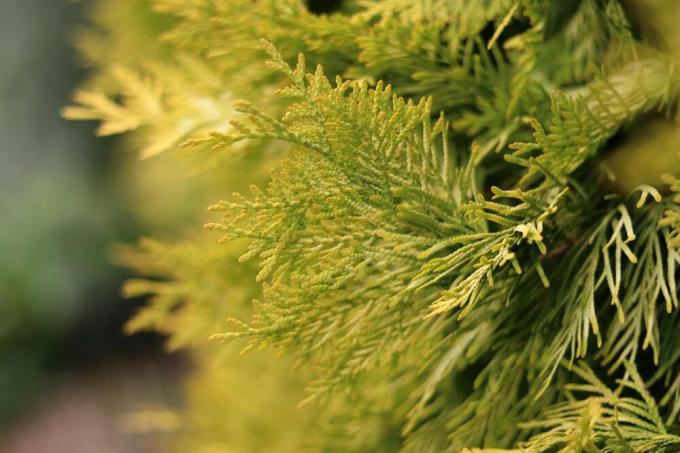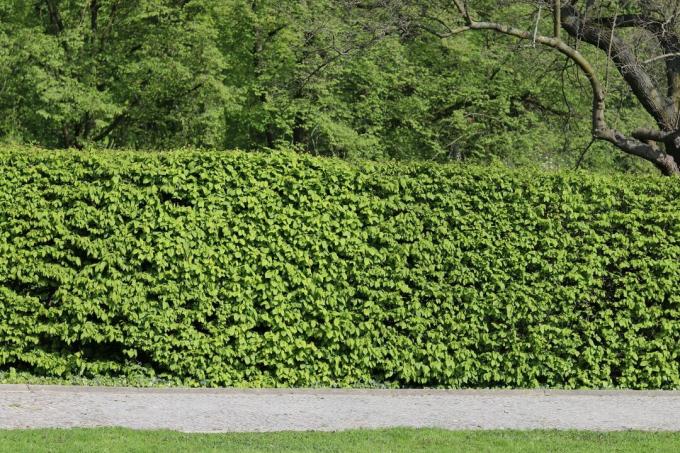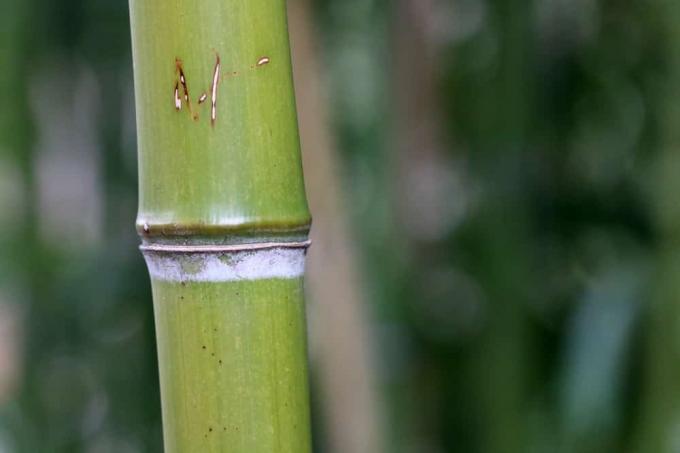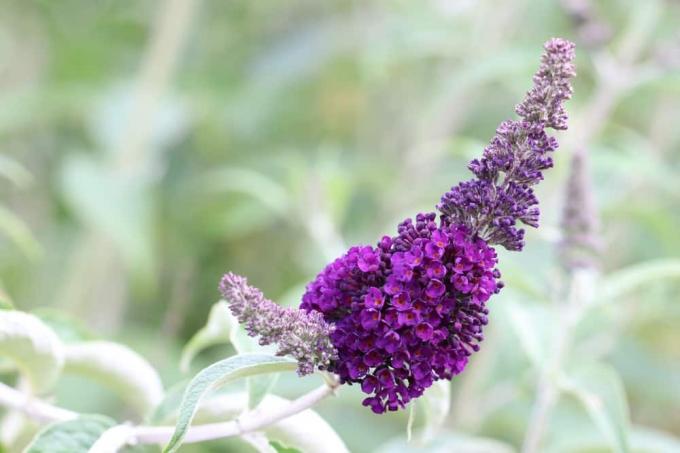

Table of contents
- Thuja brabant
- causes
- Location
- dryness
- waterlogging
- over-fertilization
- substrate
- root rot
- parasites and diseases
- Old
Thuja brabant is a very hardy, robust plant. Diseases and parasites rarely occur with her. However, mistakes in care can seriously damage the tree of life. From the wrong location to over-fertilization, unfavorable care conditions can cause discoloration. The good thing is that mistakes in care can be prevented relatively easily and they can often be remedied with little effort.
Thuja brabant
Thuja brabant - also known colloquially as the tree of life - is a very robust and resistant plant that is often used for planting hedges. Diseases and parasites usually only appear on the plant if there are mistakes in care.
causes
The causes of discoloration can be manifold. They include, among others:
- wrong location
- too much sunlight
- wrong substrate
- too dry
- waterlogging
- over-fertilization
Pests and diseases can of course also be responsible for the yellow or brown discoloration, but experience has shown that they are only the result of incorrect care conditions.
Location
The optimal location for Thuja brabant is partially shaded to sunny. The tree of life grows more loosely in partially shaded or shady locations and thus offers less privacy. If the plants are exposed to the blazing midday sun for a long time and without protection, burns can occur. The typical result is yellow to brownish discolouration. These burns are even more common if the Tree of Life has been pruned during strong sunlight. The cut surfaces not only burn more easily, but also dry out very quickly.
dryness

Drought or lack of water can significantly affect the plant. Especially in a very bright location and well-drained soil, but also in very young ones Arborvitae that have not yet had enough time to grow can quickly become affected by drought lead to damage. It is typical here that the shoots have brownish discolorations from the outside inwards. Extensive watering when necessary, for example in persistently dry phases or during growth, will help. Sections that have already dried up and died can no longer be saved in this way, but progressive changes and discolouration can be avoided.
waterlogging
Persistent wetness or waterlogging can cause root rot, discoloration and damage. This also weakens the tree of life, which can encourage infestation with germs and parasites. When choosing the location, care should therefore be taken to ensure that the planting area is not prone to waterlogging. Depressions and areas near a garden pond are therefore extremely unsuitable. When watering, you should also make sure that it is not poured too generously and that the water can drain off well.
over-fertilization
The tree of life is very frugal in terms of nutrient supply. This can lead to over-fertilization relatively quickly. Mineral fertilizers should also be avoided, as Thuja brabant is very sensitive to salts. On the other hand, mulch and organic fertilizers, such as well-rotted compost, are suitable. Conifer fertilizer specially tailored to the needs is ideal. However, these should only be administered if growth is very weak and the substrate is poor in nutrients. Even then, a single application of fertilizer per year is usually sufficient.
substrate
A slightly acidic, moist to swampy soil is well suited for Thuja brabant. However, it is important to keep the balance here. Drought is not good for the plants, but neither is waterlogging. The water should therefore be able to drain off easily. At the same time, the substrate should also be able to store moisture. If the soil is dry, a layer of mulch or gravel can help keep it from drying out as quickly. If the substrate is very moist, a drainage layer can prevent waterlogging and thus root rot.
root rot
Root rot occurs when the roots are constantly waterlogged or exposed to excessive moisture. The already mentioned drainage layer can help here. For drainage, potsherds, gravel or sand are placed in the planting hole before the tree of life is planted. This layer ensures that the water can drain off better and the roots are thus protected from waterlogging. If root rot has already occurred, the tree of life can still be saved. However, it is important to detect the disease early.

It expresses itself through:
- weakened growth
- first yellow discoloration, then brown discoloration
- gradual death of roots and plant
If all care errors apart from waterlogging can be ruled out, root rot is a comparatively probable disease. The affected growths can be saved if the following steps are followed:
- Carefully dig up Thuja brabant and rinse the soil off the root ball.
- Cut off damaged root areas with sharp scissors.
- Allow root ball to air dry for a few hours.
- Change the soil around the planting hole and treat with an appropriate fungicide to be on the safe side.
- Bring in the drainage layer and reinsert the tree of life.
Even after this measure, there is no guarantee that the crop will survive. However, there is a possibility of salvation.
parasites and diseases
Thuja brabant is inherently resistant to parasites and diseases. Problems usually only arise if previous care mistakes existed and the plant was weakened as a result. The most common are root rot and other fungal diseases. Appropriate fungicides can be used to counter this.
Old
Thuja brabant wilts from the inside out over time. Sections that have turned brown can therefore also be due to age or incorrect blending. Regular blending from the start can be helpful. Care should be taken not to cut right into the old wood.
If you cut into the old wood, brown or bare spots or gaps remain.
 garden editorial
garden editorial I write about everything that interests me in my garden.
Learn more about hedges

Hornbeam hedge: 17 tips for care
Hornbeams (Carpinus betulus) are most commonly used as topiaries or hedge plants. They are actually not beeches at all, but belong to the birch family. The hornbeam is very robust, easy to care for and, in contrast to the common beech, not poisonous.

How fast does bamboo grow? | Information about growth
In domestic gardens, bamboo is usually used as a privacy screen or as a decorative solitary plant. The rapid growth, which can reach several cm a day, is impressive. It depends on the bamboo variety, care and the prevailing microclimate.

How fast does cherry laurel grow? | accelerate growth
The cherry laurel is a fast and densely growing tree. After planting, it usually only takes a few years for the young plants to grow into a tall, dense and evergreen hedge. In addition, growth can be accelerated by additional precautions.

Creating a mixed colorful hedge: 9 ideas for a mixed hedge
If you don't like it monotonous, you can also create a mixed hedge instead of a hedge from a single, evergreen plant species. There is a wide range of colorful hedges to choose from. There are special flowering hedges, ones for birds, scented ones, or for insects and butterflies.

Yellow cypress | 9 tips for care, pruning & growth
The yellow cypress is one of the most common hedge plants in our gardens. No wonder: it combines a great look with an opaque growth. How to properly care for them, cut them and generally promote their growth is here.

The optimal hedge: Arborvitae, yew and cypress trees are good
Green hedges fulfill two wishes at once: they are a fence and at the same time a piece of nature. They do their job perfectly and still leave room for beauty. They do not weather and do not need painting. May it be a tree of life, yew or cypress?
